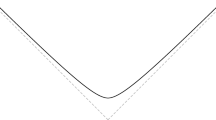Abstract
We define a relative entropy for two self-similarly expanding solutions to mean curvature flow of hypersurfaces, asymptotic to the same cone at infinity. Adapting work of White (Indiana Univ Math J 36(3):567–602, 1987) and using recent results of Bernstein (Asymptotic structure of almost eigenfunctions of drift laplacians on conical ends) and Bernstein-Wang (The space of asymptotically conical self-expanders of mean curvature flow), we show that expanders with vanishing relative entropy are unique in a generic sense. This also implies that generically locally entropy minimising expanders are unique.
Similar content being viewed by others
References
Angenent, S., Ilmanen, T., Chopp, D.L.: A computed example of nonuniqueness of mean curvature flow in \({ R}^3\). Commun. Partial Diff. Equ. 20(11–12), 1937–1958 (1995)
Bernstein, J.: Asymptotic structure of almost eigenfunctions of drift laplacians on conical ends, Preprint. arXiv:1708.07085v2
Bernstein, J., Wang, L.: The space of asymptotically conical self-expanders of mean curvature flow, Preprint. arXiv:1712.04366
Ding, Q.: Minimal cones and self-expanding solutions for mean curvature flow, Preprint. arXiv:1503.02612v2
Gilbarg, D., Trudinger, N.: Elliptic partial differential equations of second order. Springer-Verlag, Berlin (2001)
Hörmander, L.: The boundary problems of physical geodesy. Arch. Rational Mech. Anal. 62(1), 1–52 (1976)
Ilmanen, T.: Lectures on Mean Curvature Flow and Related Equations, preliminary version, available under http://www.math.ethz.ch/~ilmanen/papers/notes.ps
Ilmanen, T., Neves, A., Schulze, F.: On short time existence for the planar network flow, Preprint. arXiv:1407.4756, to appear. J. Diff. Geom
Simon, L.: Lectures on geometric measure theory. Centre for Mathematical Analysis. Australian National Unversity, Canberra (1983)
Wang, Lu: Uniqueness of self-similar shrinkers with asymptotically conical ends. J. Am. Math. Soc. 27(3), 613–638 (2014)
White, Brian: The space of \(m\)-dimensional surfaces that are stationary for a parametric elliptic functional. Indiana Univ. Math. J. 36(3), 567–602 (1987)
Acknowledgements
The authors wish to thank Tom Ilmanen for sharing his ideas. A.D. was supported by the grant ANR-17-CE40-0034 of the French National Research Agency ANR (project CCEM). F.S. was supported by a Leverhulme Trust Research Project Grant RPG-2016-174.
Author information
Authors and Affiliations
Corresponding author
Additional information
Communicated by F.C. Marques.
Publisher's Note
Springer Nature remains neutral with regard to jurisdictional claims in published maps and institutional affiliations.
Appendices
Appendix A. Geometry of normal graphs
Let again \(\Sigma _0,\Sigma _1\) be two expanders asymptotic to the cone \(C(\Gamma )\), and assume \( {\bar{E}}_{1,R_0} = \text {graph}_{{\bar{E}}_{0,R_0}}(u)\) with \(u : {\bar{E}}_{0,R_0} \rightarrow {\mathbb {R}}\). Let \(p \in \Sigma _0\) and choose a local parametrisation F, parametrising an open neighbourhood U of p in \(\Sigma _0\) such that \(F(0)=p\). We can assume that \( g_{ij}=\langle \partial _i F, \partial _j F \rangle \) satisfies
For simplicity we can furthermore assume that the second fundamental form \((h_{ij})\) is diagonalised at p with eigenvalues \(\lambda _1,\ldots , \lambda _n\). A direct calculation, see [10, (2.27)], yields that the normal vector \(\nu _1(q)\), where \(q = p + u(p) \nu _0(q)\), is co-linear to the vector
Denoting the shape operator \(S = (h^i_{\ j})\) we see that thus in coordinate free notation
where \(v:=(1 + |(\text {Id} - uS)^{-1}(\nabla _{\Sigma _0} u)|^2)^{\frac{1}{2}}\). This implies
For the induced metric \({{\tilde{g}}}\) one obtains in the above coordinates at p, again see [10, (2.32)],
which implies
Furthermore, from [10, (2.30)] we have
Since \(H_{\Sigma _1}(p) = {{\tilde{g}}}^{ij}(p) {{\tilde{h}}}_{ij}(p)\) we see that
where \(Q(x,u,\nabla ^{\Sigma _0} u , \nabla _{\Sigma _0}^2 u)\) is quadratic in \(u, \nabla ^{\Sigma _0} u, \nabla _{\Sigma _0}^2u\).
Appendix B. Interpolation inequalities
We recall the following standard interpolation inequalities in multiplicative form.
Lemma B.1
Suppose that \(u \in C^{k}(B_{2})\), then for \(j< k\),
for \(C=C(n,k)\). Similarly, if \(u \in C^{k,\alpha }(B_{2})\), then for \(j+\beta < k+\alpha \),
for \(C=C(n,k,\alpha ,\beta )\).
These follow in a similar manner to the linear inequalities given in [5, Lemma 6.32], except in the proof one should optimize with respect to the parameter \(\mu \) rather than just choosing \(\mu \) sufficiently small. Alternatively, see [6, Lemma A.2].
Rights and permissions
About this article
Cite this article
Deruelle, A., Schulze, F. Generic uniqueness of expanders with vanishing relative entropy. Math. Ann. 377, 1095–1127 (2020). https://doi.org/10.1007/s00208-020-02004-6
Received:
Revised:
Published:
Issue Date:
DOI: https://doi.org/10.1007/s00208-020-02004-6



